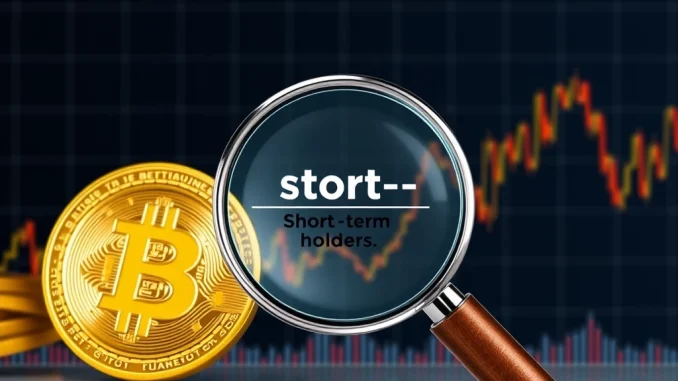
Are you navigating the volatile world of cryptocurrency and wondering what the latest market signals are telling us? The Bitcoin market is constantly evolving, and understanding the nuances of holder behavior can provide powerful insights into potential market directions. Recent on-chain data reveals a fascinating trend: the share of Bitcoin held by short-term holders has significantly decreased. Let’s dive deep into what this means for the current bull market and what you should be watching.
Decoding the Dip: Short-Term Bitcoin Holder Supply
According to recent data from the esteemed on-chain analytics firm Glassnode, the proportion of Bitcoin’s total supply held by short-term holders has fallen to approximately 40%. This figure is noteworthy because it represents a considerable decrease from earlier in 2025 when short-term holders accounted for nearly 50% of the Bitcoin supply. To truly grasp the significance of this shift, let’s break down what ‘short-term holders’ and this metric actually signify:
- Short-Term Holders (STHs): These are Bitcoin addresses that have held their BTC for less than 155 days. They are often considered more speculative and reactive to market fluctuations.
- STH Supply Percentage: This metric indicates the percentage of the total circulating Bitcoin supply that is currently held by these short-term market participants.
- Current Trend: The decrease to 40% suggests a shift in market dynamics, moving away from the high levels of short-term speculation observed in previous market cycles.
This reduction is not just a minor fluctuation; it’s a signal with historical context. In previous Bitcoin bull market peaks, the short-term holder supply share surged to much higher levels – between 70% and 90%. The current 40% is significantly lower, indicating a fundamentally different market structure this time around.
Why Does the Short-Term Holder Ratio Matter for the Bitcoin Bull Market?
Understanding the distribution between short-term and long-term holders is crucial for gauging the health and maturity of a Bitcoin Bull Market. Here’s why this metric is so insightful:
- Market Maturity Indicator: A lower percentage of short-term holder supply can suggest a more mature bull market. It implies that a larger portion of Bitcoin is held by investors with longer-term conviction, reducing the likelihood of drastic sell-offs triggered by short-term price volatility.
- Reduced Speculative Frenzy: High short-term holder ratios often coincide with periods of intense speculative buying and market euphoria. The current lower ratio suggests a more tempered and sustainable growth phase, rather than a purely speculative bubble.
- Stronger Market Foundation: When long-term holders dominate, it creates a stronger foundation for price appreciation. These holders are less likely to sell during minor corrections, providing stability and reducing downward pressure.

Comparing Cycles: How Does This Bull Market Differ?
To truly appreciate the current market scenario, let’s compare it to previous Bitcoin cycles. In past bull runs, especially near market tops, we typically witnessed:
| Market Phase | Short-Term Holder Supply (Approx.) | Market Sentiment | Market Behavior |
|---|---|---|---|
| Previous Bull Market Peaks | 70% – 90% | Extreme Euphoria, Greed | Rapid Price Surge, High Volatility, Speculative Frenzy |
| Current Bull Market | Around 40% | Moderate Optimism, Cautious Growth | Steadier Price Appreciation, Lower Volatility Compared to Peaks, More Distributed Accumulation |
This comparison highlights a significant difference. The current crypto market analysis suggests a more ‘milder’ or ‘moderate’ bull market, as described in the initial report. This doesn’t necessarily mean less profit potential, but it could imply a more sustainable and less volatile upward trajectory.
The Role of Long-Term Bitcoin Holders
If short-term holders are accounting for a smaller slice of the Bitcoin pie, who’s picking up the slack? The answer lies with long-term Bitcoin holders. These are entities that have held their Bitcoin for more than 155 days. Their behavior is often seen as a barometer of long-term market confidence. A decrease in short-term holder supply often corresponds with an increase, or at least a stable high level, of long-term holder accumulation. This indicates:
- Strong Conviction: Long-term holders are typically less swayed by short-term price swings. Their continued holding pattern suggests strong belief in Bitcoin’s long-term value proposition.
- Supply Squeeze Potential: As more Bitcoin is locked up in long-term storage, the available Bitcoin Supply on exchanges decreases. This can create a supply squeeze, potentially driving prices higher as demand increases or remains constant.
- Mature Investor Base: A market dominated by long-term holders often signifies a maturing investor base, one that is less driven by hype and more by fundamental value and long-term growth prospects.
Implications for Your Crypto Strategy
So, what actionable insights can we derive from this shift in short-term Bitcoin holders distribution? Here are a few key takeaways for your crypto strategy:
- Assess Risk Tolerance: A milder bull market may offer a less frantic, but potentially more sustainable, growth environment. Adjust your risk tolerance accordingly. Consider that rapid, speculative gains might be less prevalent than in previous cycles, but steady, long-term appreciation could be more likely.
- Focus on Long-Term Value: This market signal reinforces the importance of focusing on the long-term fundamentals of Bitcoin and other cryptocurrencies. Projects with strong use cases, solid technology, and growing adoption are likely to thrive in a more mature market.
- Monitor On-Chain Metrics: Keep an eye on on-chain metrics like short-term and long-term holder ratios, exchange flows, and accumulation trends. These data points can provide valuable early signals of market shifts and potential opportunities.
- Diversify Strategically: While Bitcoin remains the flagship cryptocurrency, a more moderate bull market might present opportunities in other areas of the crypto space. Explore diversification into promising altcoins, DeFi projects, or emerging trends, but always with thorough research and risk management.
Is This a Warning Sign or a Healthy Correction?
It’s essential to ask: is this decrease in short-term holder supply a warning sign of a weakening bull market, or is it a healthy correction indicating a more sustainable climb? The consensus leans towards the latter. A market driven predominantly by short-term speculation is inherently unsustainable and prone to dramatic crashes. A shift towards long-term holding and a reduction in speculative frenzy can be viewed as a sign of market maturation and a more solid foundation for continued growth. However, it’s crucial to remain vigilant and continuously monitor various market indicators.
Conclusion: A Steadfast Path Forward for Bitcoin
The current data on on-chain metrics, particularly the decreasing share of Bitcoin held by short-term holders, paints a picture of a evolving bull market. It’s a market that appears to be less driven by short-term hype and more by long-term conviction. This shift suggests a steadier, more sustainable growth trajectory for Bitcoin. While the explosive gains of hyper-speculative phases might be less pronounced, the potential for long-term appreciation remains robust. By understanding these market signals and adapting your strategy accordingly, you can navigate this evolving landscape with greater confidence and potentially unlock significant opportunities in the world of cryptocurrency.



